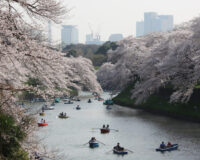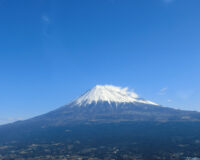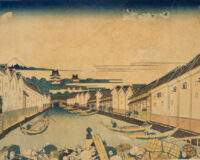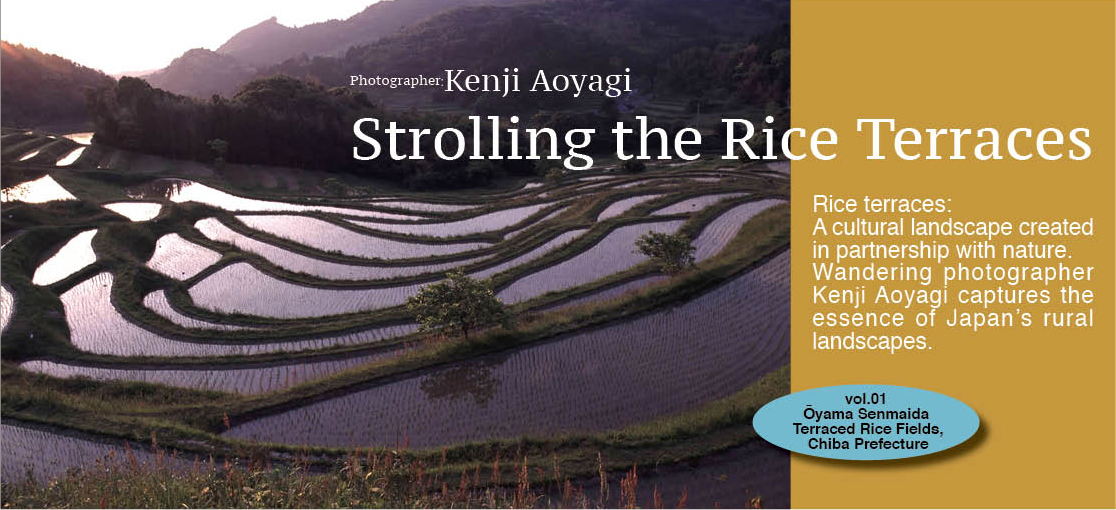
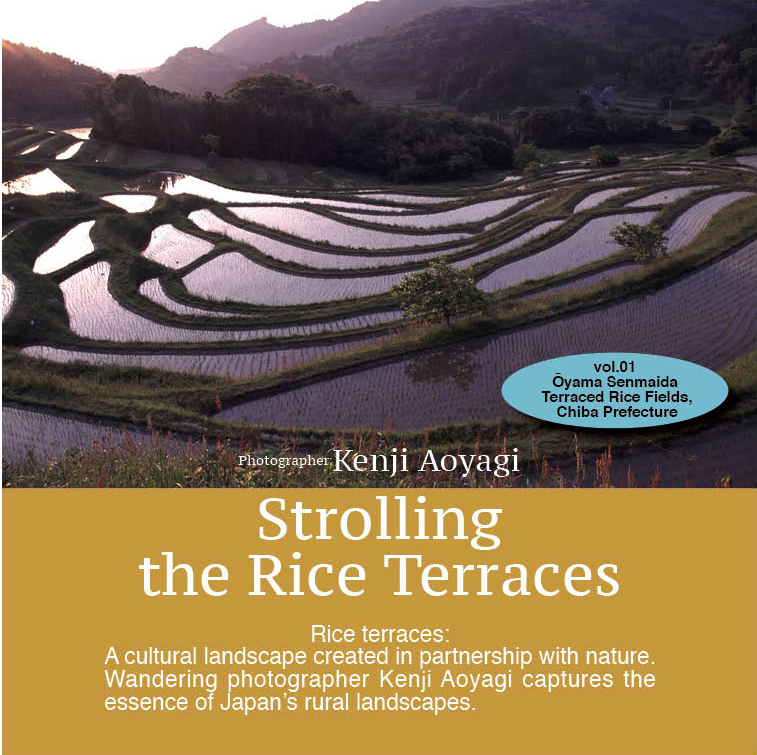
Rice terraces: A cultural landscape created in partnership with nature. Concern over the gradual loss of Japan’s terraced rice fields has been growing in recent years. Reasons for the abandonment of the rice terraces are said to be twofold. On the one hand, the consumption of rice in Japan has decreased since the Second World War as the Japanese have adopted a more Westernized diet. Along with that, a move towards mechanisation and efficiency in farming has made the growing of rice in secluded mountain areas economically unsustainable. Ironically, it is only since the rice terraces started disappearing that we have begun to recognise their importance. Wandering photographer Kenji Aoyagi captures the essence of Japan’s rural landscapes.
Photos and Text : 青柳健二 Kenji Aoyagi / English Version : Judy Evans
Keyword : Rice Terraces / Farming / Horticulture / Oyama Senmaida / Rice / Chiba Prefecture
Beautiful Rice Terraces Sustaining People and Nature
Serving as more than just sites for rice production, the multiple benefits and values of rice terraces are being reassessed. These benefits include: their scenic value; their cultural legacy; flood protection and land conservation values, and ecosystem values as habitat for a wide variety of wildlife.
In 1999, the Japanese Ministry of Agriculture, Forestry and Fisheries compiled a list known as ‘Japan’s Top 100 Rice Terraces’. It was in this year that maintenance and preservation of Japan’s rice terraces began in earnest.
Not too far from Tokyo, at a distance of ninety-two kilometres or two hours by car, Chiba Prefecture’s Ōyama Senmaida is one of those ‘Top 100 Rice Terraces’. Nestled in the hills fourteen kilometres west of Kamogawa City, Ōyama Senmaida’s 375 south-east facing rice fields have become such an attraction that even tour buses visit. Ōyama Senmaida is one of the most unusual of Japan’s top 100 rice terraces, having no natural water source to rely on for irrigation other than the rain, and is considered to be a treasure trove of biodiversity. In 2002, Ōyama Senmaida was officially designated by Chiba Prefecture as a Prefectural Landmark.
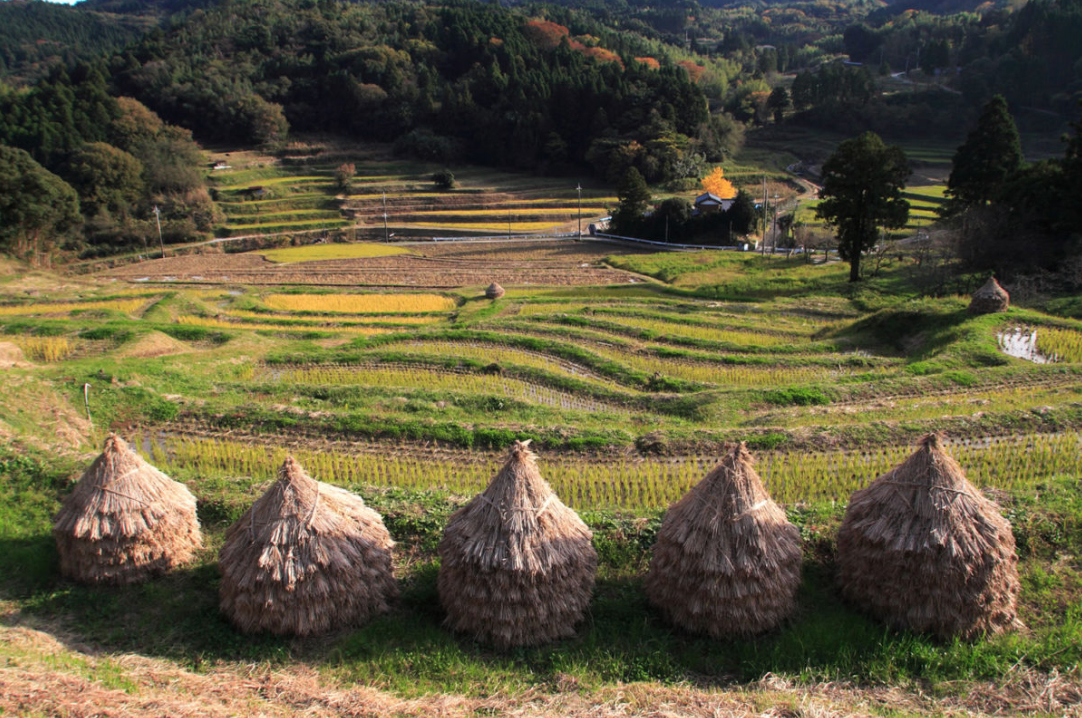
Understanding the importance of living in harmony, as part of the rural landscape
People have long appreciated the beauty of Japan’s rice terraces throughout the seasons: a cascading landscape of tiny ponds in spring; the lush greens of summer; the yellows and golds of the autumn grains, bursting with ripeness and waiting to be harvested. The changing appearance of the rice terraces is one of their charms; even long after the harvest, the withered fields of winter have their own beauty.
Plans for the stewardship of Ōyama Senmaida’s heritage landscape began in 1997, with the formation of the Ōyama Senmaida Preservation Society. In March, 2000, the ‘Tanada (rice terrace) Ownership System’ was introduced, whereby people lease a section of the rice terraces and experience rice-growing first hand. Supported by local farmers and experts, they participate in the planting and harvesting of the rice, and receive in return some of the rice they harvest. The proposal was met with a great response and in the first year, thirty-nine groups came forward to participate in this stewardship programme. Partly due to Ōyama Senmaida’s proximity to urban areas, the number of applications from groups wishing to take part in this programme has now risen to one hundred and thirty-six.
One of the more unique activities undertaken to support the stewardship of the Ōyama Senmaida rice terraces is Kamogawa’s Satomai Ballet, which takes rural mountain living as its theme. The Satomai Ballet was created in time for the 2002 Tanada Summit (an annual event involving representatives from rice terraces all over Japan), held in Kamogawa City. They currently perform at Ōyama Senmaida events. In 2014 the group even performed in Tokyo, and in 2015 they were awarded the Tanada Gakkai Prize for their efforts. Junko Nagamura, head of the Satomai Ballet, describes their work as ‘a narrative around the imaginary landscape of the animals and people who live in the rural hill country’. She goes on to say that, ‘these are places where generations of people have tilled the soil and maintained the terraces. We sense their wisdom in the curves of the terraces. In these hills that we call satoyama, somewhere between the mountains and the plains, there is so much life: trees, flowers, insects, birds and wild animals. Living here, we achieve our best by bringing nature into our lives’.
Supporting the preservation of rice terraces through the medium of ballet is certainly unusual. But, watching the Satomai Ballet, one gets a sense of both strength and grace. The dancers are children born in this satoyama hill country, and mothers who have raised their children here. The high regard in which the Satomai Ballet is held is due to the fact that it is more than simply a work of art; it is a work of art that is firmly rooted in the local soil – and one that is forging new links between the rice terraces and an increasingly wide range of people.
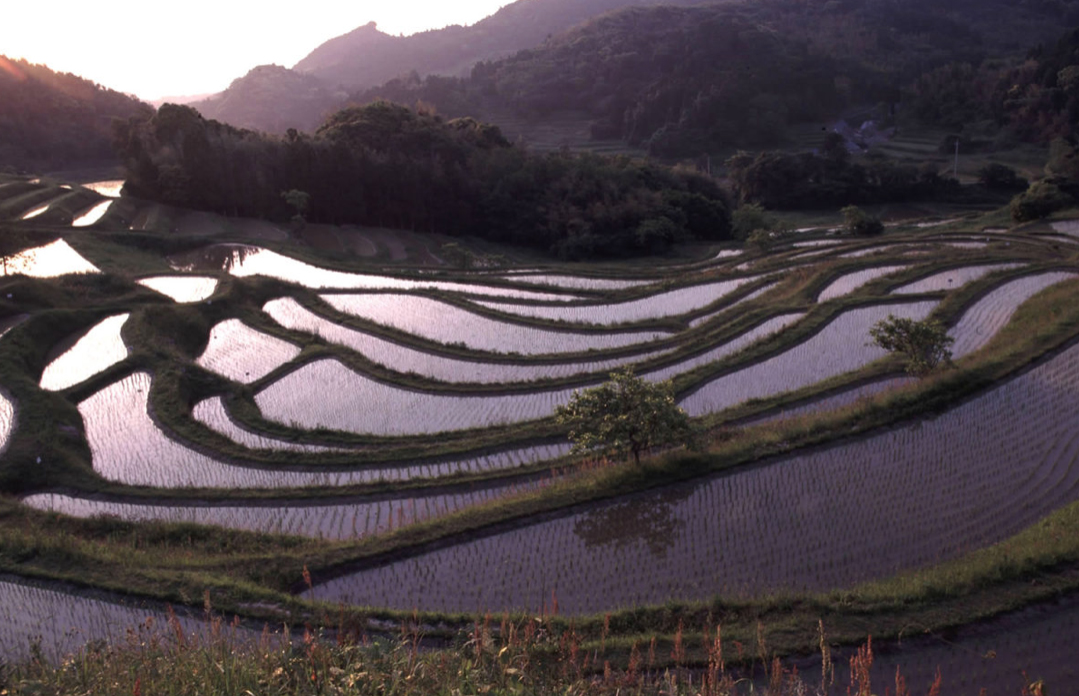
Contact:
Kamogawa City Hall
Yokosuka 1450
Kamogawa-City, Chiba-Prefecture
Japan, 296-8601
Phone: +81-4-7092-1111


